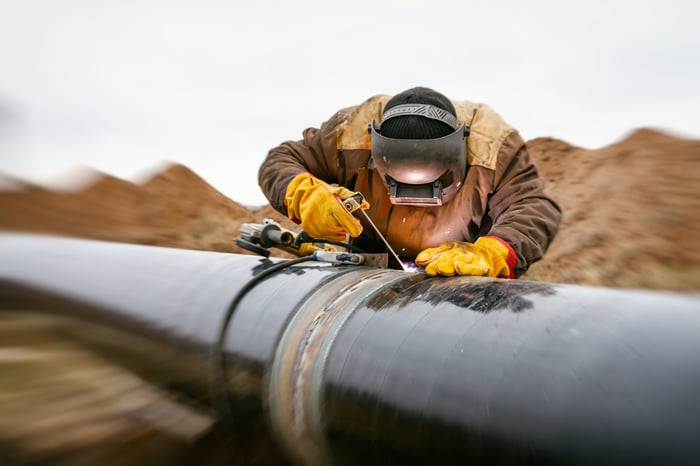Kinder Morgan (KMI 0.27%) shocked investors in 2016 when it cut its dividend following management's statement that a dividend increase was in the cards. While that might lead conservative investors to avoid the stock because of trust issues (a completely reasonable response), the giant midstream company has been working hard to regain the support of Wall Street.
And it is in a vastly different position today than it was back then, with the next three years in position for well-supported business and dividend growth.
Getting back on track
There's no question that trust has to be earned, and Kinder Morgan's 2016 dividend cut did great harm to its once-solid reputation as a reliable dividend stock. But the midstream company's situation today is very different from what it was then.
For example, the third-quarter dividend was covered by distributable cash flow by nearly 1.8 times. That leaves a lot of room for adversity before a dividend cut would be needed. By comparison, in the third quarter of 2015, before the dividend was cut, the company paid out all of its distributable cash flow as dividends.

Image source: Getty Images.
It's also instructive to consider what caused the 2016 dividend cut. Essentially, management was faced with a difficult energy market, and with a heavy debt load, it had to choose between investing in the business or continuing to support the dividend. It clearly chose to invest in the business.
And while the company's ratio of financial debt to earnings before interest, taxes, depreciation, and amortization (EBITDA) isn't at the low end of similarly sized peers, it also isn't out of line (or at the highest level). So the strong distribution coverage should provide the leeway needed to ensure that management doesn't need another cut to keep spending on its capital investment plans. And that brings the story all the way around to where Kinder Morgan will be in three years' time.
Bigger
With a $40 billion market cap, Kinder Morgan is a giant in the North American midstream sector, with a vast collection of well-situated pipeline, storage, processing, and transportation assets. It would be virtually impossible to replace what it owns.
That, however, is only so good when it comes to growth. These largely fee-based infrastructure assets throw off reliable revenue, but the revenue growth opportunity is fairly limited. And that means that Kinder Morgan needs to build or buy new assets if it wants to grow in a material way.
It's impossible to predict acquisitions, but Kinder Morgan has laid out its capital investment plans. In total, management is expecting to spend $2.7 billion on projects, with 15% due to come on line in 2022, 60% in 2023, and 25% in 2024 and beyond. As these projects are completed, they will start to generate cash flow and likely increase the company's ability to grow its dividend over time.
The vast majority of the outlay will be in the natural gas space, at around 60% of total spending. Natural gas is being used as a transition fuel, reducing the need for dirtier carbon fuels as the world builds out its clean-energy fleet.
The rest of the spending is spread across various business units, with a notable focus on clean-energy projects in renewable diesel, renewable natural gas, and the company's carbon dioxide business.
Management is expecting annual spending between $1 billion and $2 billion. That's down from historical levels (between $2 billion and $3 billion), but it still directionally supports ongoing business growth and dividend growth. So even after the next few years, getting bigger is still the basic goal.
For the forgiving sort
As noted above, Kinder Morgan probably isn't appropriate for the most risk-averse investors because of the 2016 dividend cut. But management has done a lot to regain the trust of Wall Street, notably including the company's robust dividend coverage ratio. And it is -- as it always has been -- focused on growing the business.
When you combine that with the better positioning of the dividend, it looks like bigger and better is what more-adventurous and forgiving dividend investors should expect from Kinder Morgan over the next three years and beyond.





